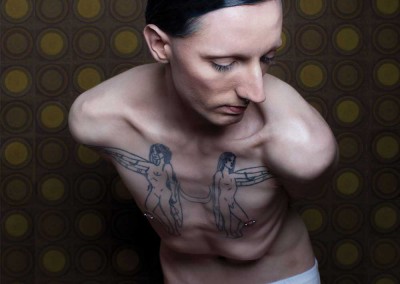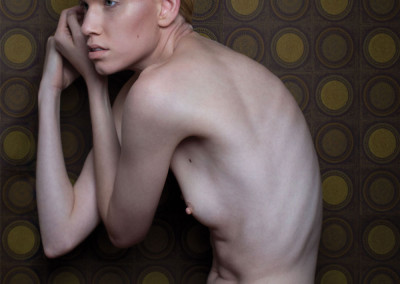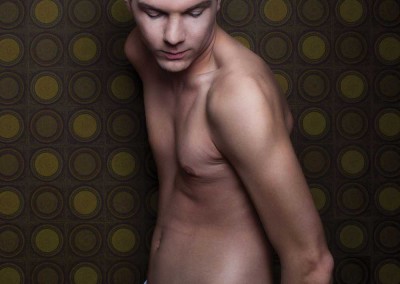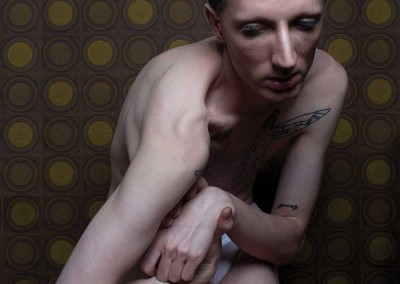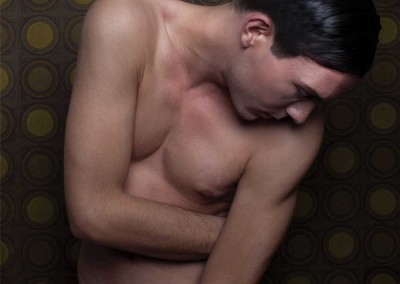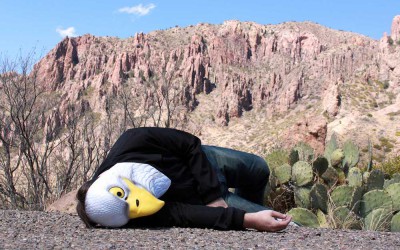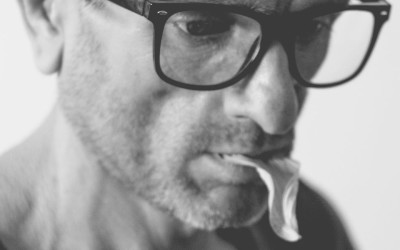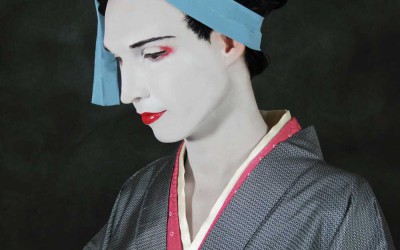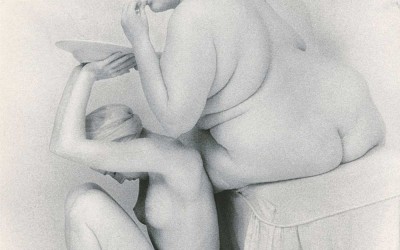Roxanne Bauwens
Text JF. Pierets Photos Roxanne Bauwens
Her website states: ‘So far I have done research on various topics: identity, beauty ideals, (ab) normality, medical abnormalities, skin, perception, genderbending and uniqueness in contrast to uniformity.’ Needless to say we were very intrigued on hearing more about visual artist Roxanne Bauwens. A conversation about beauty, open-mindedness and the human soul.
Your work evolves around your personal vision on beauty. Why?
I’ve always been very interested in the concept of beauty, or better, what people believe is beautiful. Like most young girls I used to slide through fashion magazines, and like probably all of them I always ended up with a feeling that I didn’t live up to those standards. I guess my former huge unibrow must have had something to do with that. Now that I’m older people consider me a beautiful woman, yet most of the time it doesn’t go any further or beyond that observation. I guess that’s why I find it so important to attach great significance to what’s real and what’s not. To show a different point of view.
So it’s a personal evolution?
For me art is all about evoking and projecting. Yet you need experience in order to evoke or project something relevant. I guess part of that has to do with my upbringing, since I come from a lesbian home, which was slightly off cue when I was younger. Everything about my family was just a little bit different from my friends’ families. In addition that made me also a bit ‘different’, so to speak. Never belonged, which of course I find now more enjoyable than back then.
Can you define beauty?
When you search for the definition of beauty, you get the following: ‘The quality present in a thing or person that gives intense pleasure or deep satisfaction to the mind, whether arising from sensory manifestations (as shape, color, sound, etc.), a meaningful design or pattern, or something else (as a personality in which high spiritual qualities are manifest).’ For me, beauty is the inside that manifests itself on the outside. When I’m working with models, I choose them because of their divergent features, the non-typical beauties. I always had a soft spot for imperfections, which I found more intriguing. Those little off-guard proportions that make a person unique.
Aren’t those people insecure in front of the camera, just because of that?
Yes, and it’s very difficult to convince them of loosing their masks. My projects deflect from societies beauty standards so the first thing I need to do is to earn their trust. I’m familiar with most of the models I work with but still, they have to be confident that I’m not going to go into some weird zone once I handle my photoshop tools. Once I had a model that left. Who told me he couldn’t do it because it was too intense.
You ask a lot.
I do. I ask for people to open up. To go, sometimes literally, naked. To show me their soul. Which is often very uncomfortable and difficult for an adult person. I’m aware of the fact that the word soul is often used in vain and is somewhat pompous to be used by an artist, but yet there’s a lot of truth to be found their. The raw, deep emotion, which is so interesting to capture with your camera.
How do you get people to go that far?
When in the studio, it’s quite an intense and psychological process because I actually ask my models to think of a traumatic or heavily disturbing moment that happened in their lives. To actually relive that experience. That’s the moment when a person becomes radiant. When you see it all.
On your website you talk about Marina Abramovich, who states in her documentary ‘The Artist is present’, that art should be made with emotions and that the artist must be one with the moment in which the work is created. Are you joining your models into the emotions?
Certainly! I make playlist of certain atmospheres and evolving certain subject matters. At that moment I also have to surrender myself to them, so music helps to build up the required mood of the moment. In order to ask people to open up to me, I have to do the same thing. It doesn’t ad any value to the work when I behave like an outsider. When I’m only playing the voyeurs role.
Do you open up yourself quite often?
Not very often. I used to do it a lot, which didn’t always have the nicest outcome. So you can say I’m careful, which I deplore and try to change on an every day basis. Yet I find it very heard to keep a certain naivety, a belief in the goodness of people. You are always looked at. Both approved or criticized.
So your work might be a contra reaction on how people react on you, as a person?
Maybe it is. Maybe I like to provoke. Try to make people a bit more open-minded. And that doesn’t always has to be about the big gestures. You can also make change by dropping little visual thrills. Like my pictures.
Do you have the feeling people are looking at your work the way you want them to?
Some of them do. And don’t get me wrong, I’m not preaching for people to think the same way as I do. But it always feels like a victory when they ‘get’ it or are willing to open up for my work. I’m sincerely able to find people extremely beautiful, even when others consider them ugly. Just because of that certain fragility, the vulnerability, so to speak. Everything is clean and photoshopped nowadays. We’re flooded by fake smiles, clothes that speak of the wearer’s money value. I want my spectators to actually see the person behind the face, to be able to feel and see exactly the same as the one on the picture.
‘Androgyny is very difficult to capture because the moment you wonder whether a person is a boy or a girl, that’s the moment you see true beauty.’
To see beauty beyond the obvious.
And to define beauty for themselves. Not thoughtlessly taking over what’s been told to think. Of course you have those things called the golden ratio or symmetry, which makes people like Kate Moss or Angelina Jolie universal beauties. But I like asymmetrical faces more. That makes a person interesting. Stratification between the inner person and the way he or she exposes himself on the outside. You don’t always get what you see. And happy not to.
How do you start a new series?
That depends. Often I get my inspiration from experiencing life. That, and a great deal of research; documentaries on the subject of beauty, the evolution of beauty in art history. I’m the research kind of girl. Most of the time it’s a symbioses of those two. Efficient knowledge combined with a certain mood or emotion once experienced. Than I start looking for all the ingredients to merit that particular atmosphere. My previous work also guides me into new projects since I keep on learning about new techniques, or the way the light captures a piece of skin in a satisfying manner. That kind of approach leads to the fact that all my work is a result of the foregoing ones.
Why photography, since those themes are suitable for every form of art.
We experience a picture as a reproduction of reality and I want to show something that’s a bit bizarre, without being an alteration. So photography is the perfect registration tool.
Can you tell me something about the gender pictures that accompany this article?
Androgyny is very difficult to capture because the moment you wonder whether a person is a boy or a girl, that’s the moment you see true beauty. I wanted to approach as close as possible the story behind the image, go beyond the cliché of average photography. My work is pure, has no fringes, so on one side you have the toughness, the hardness which you definitely need in nowadays society and on the other hand you have that feminine softness. And for me, that’s what a person is all about. About all having a male and female identity. I also don’t believe in being 100% heterosexual, I think we’re all somewhere in-between.
Related articles
Nigel Grimmer
Quirky and theatrical, is how I described Nigel Grimmer’s work the first time I encountered it; tense and layered upon further inspection. Grimmer’s art practice is an ongoing investigation exploring the relationship between public and personal…..
A Kind of Absence
German photographer and visual artist Dirk H. Wilms focuses on self-portraits since 2001, the year he received his HIV diagnosis. After the diagnosis he barely left his house for almost four years. He thought everyone would know immediately he carried the…..
Matthijs Holland
What do historic figures like Hatshepsut, Pope Joan, Segawa Kikunojo III, Henry III of France and Charlotte von Mahlsdorf have in common? Visual artist Matthijs Holland told us all about it. Do tell! I wanted to create a photo project based on…..
Heavy in White
Lynn Bianchi is a New York City-based fine art photographer and multi-media artist who has shown work in over thirty solo exhibitions and in museums worldwide. Her photographic art has been featured in over forty publications. Bianchi’s Heavy…..
Paul Buijs
Young, reckless and fresh from the Arnhem art academy. In order to find a suitable subject for his graduation project, Paul Buijs went where no other student would follow; the shady underworld of gay darkrooms and sex parties. Hovering…..

